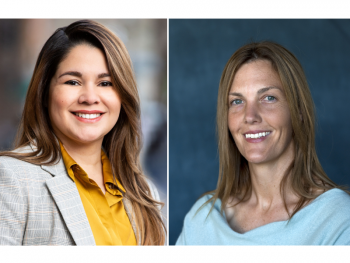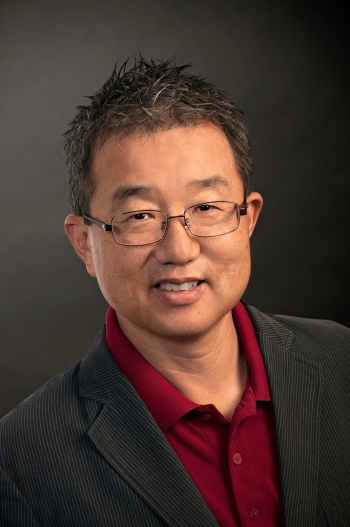Hundreds of academics gather at research conference about harm from firearms
Recent gun safety proposals — including requiring gun locks and community beautification efforts that can help quell violence — could possibly earn support from those on both sides of the firearms debate, according to two Arizona State University criminology and criminal justice professors.
Professors Jesenia Pizarro and Beth Huebner recently returned from the second annual conference of the Research Society for the Prevention of Firearm-Related Harms, held Nov. 1–3 in Chicago, where they were panelists at a workshop on how researchers can better collaborate with criminologists.

Professor Jesenia Pizarro (left) and Professor Beth Huebner, ASU School of Criminology and Criminal Justice. Courtesy photos
Download Full Image
Huebner is the Watts Endowed Professor of Public Safety and director of the ASU School of Criminology and Criminal Justice. Pizarro, a full professor, is secretary of the society, a national organization of mostly academics in health fields who conduct research but do not engage in advocacy. As a criminologist, Pizarro said she is a rare exception among the society’s membership.
More than 700 mostly academics attended the conference to hear 333 presentations by 299 unique presenters representing 34 states and five countries. More than 18 research disciplines were represented in the presentations, including medicine, public health, anthropology, business, economics, criminology/criminal justice, sociology, social work and engineering.
The society organized the conference with support from the University of Michigan Institute for Firearm Injury Prevention, the Columbia Scientific Union for the Reduction of Gun Violence (SURGE) and ASU’s School of Criminology and Criminal Justice. Here is a complete list of the conference’s sponsors.
Read on to learn Pizarro’s and Huebner’s insights from the event.
Editor’s note: Answers may have been edited for length or clarity.
Question: Professor Pizarro, you are the national secretary of the Research Society for the Prevention of Firearm-Related Harms. Tell us about its history and goals, as well as some examples of its current research.
Pizarro: The society, and by extension the conference, is rooted in a journey of overcoming obstacles. In 1996, Congress passed the Dickey Amendment, which prohibited the use of federal funds to advocate or promote gun control, which discouraged the Centers for Disease Control and other federal agencies from awarding research money targeted for firearm injury prevention.
In 2018, after multiple mass-shooting tragedies and increasing public demand, Congress clarified that the amendment does not prohibit federal funding of research on the causes of gun violence. Subsequently, the Firearm Injury Among Children and Teens Consortium (FACTS) was funded by the National Institute of Child Health and Human Development. I was one of 25 scientists in the original consortium — and the only criminologist.
Our efforts flourished and led to the 2022 national conference, which was a collaboration between FACTS, the University of Michigan and the RAND Corporation. The society was born from that effort. The society’s goal is to sustain the annual conference, nurture researchers and contribute to evidence-based policies. It is poised to shape the future of firearm injury prevention by offering a robust platform for research, publications and global initiatives combating firearm-related harms.
Q: On Nov. 7, the U.S. Supreme Court heard arguments in United States v. Rahimi, a Texas case about whether the government can restrict the Second Amendment right to bear arms of a person who is subject to domestic violence restraining orders. What might such a decision say about how our legal system treats firearm-related harm?
Pizarro: U.S. vs. RahimiAn amici curiae brief presented to the Supreme Court in U.S. v. Rahimi was signed by Pizarro and 110 other public health researchers and lawyers. View it at: https://tinyurl.com/ny4nhy46 focuses on whether the restriction of the Second Amendment rights of individuals under a domestic violence protection order is constitutional. Earlier this year, the fifth U.S. Circuit Court of Appeals ruled it is not. … The Supreme Court decision will shape the legal stance on the Second Amendment and will have crucial implications for public safety.
Acknowledging that I am not a legal scholar or constitutional lawyer, in my opinion, if the Supreme Court sides with the appellate court, it will signal to the country that individual rights supersede public safety and health. If the Supreme Court does not side with the circuit judges and decides to keep the federal statute as is, it will signal that they are committed to a nuanced understanding of the role of firearms in societal harms in light of the constitutional framework.
Q: You are a criminologist in an organization primarily made up of researchers from health fields such as public health, medicine, epidemiology and so on. Why do you think a wider, multidisciplinary approach is needed to help policymakers on issues related to the harms caused by firearms?
Pizarro: Firearm harms is one of those problems that are just too large to be understood and solved by a single discipline. Single-discipline approaches, while offering ease and simplicity for the professionals utilizing them, are insufficient to address the complexity and scale of firearm harms. For example, employing only a criminal-justice-centered approach would not consider trauma-informed services to survivors and primary and tertiary prevention efforts that are so necessary. … We need everyone at the table so that the problem can be targeted via multiple angles and considering the diverse factors that contribute to these harms.
Q: Professor Huebner, ASU’s School of Criminology and Criminal Justice is one of the most highly ranked schools in the nation. What role can the school play in shaping the research agenda regarding firearms-related harms? What expertise can it bring?
Huebner: Effective interventions to reduce firearm harm require a nuanced understanding of individuals who perpetuate harm and victims of crime, as well as in-depth knowledge of crime data and the criminal justice and social services agencies that work in the community. The multidisciplinary nature of the School of Criminology and Criminal Justice, specifically, and that of ASU as a whole, makes the school well poised to lead in this field.
We have experts, like Professor Pizarro, who have centered their research program on the multifaceted nature of gun crime, which includes in-depth knowledge of victims of violence and the nationwide landscape of gun crime, particularly homicide trends. Professor William Terrill, who also attended the conference, works with police agencies in the Phoenix area and across the country to better understand police officer perceptions of firearm danger and ways to de-escalate violence among citizens and law enforcement.
Just as important, our faculty partners with other experts at ASU and elsewhere in the fields of public health, medicine, sociology and social work to develop interventions.
Q: Now that you’ve attended this conference, what impressions did you take with you? What opportunities do you see coming out of it for the society as an impartial voice?
Huebner: This was my first time attending the conference, and I found it to be one of the best convenings I have attended. What impressed me most was the diversity of individuals who attended. I was asked to participate in a mentoring session for early-career scholars, and I connected with some of the brightest minds in the field. I also appreciate that the group takes a public health approach and allows those who work on the front lines with victims to have a strong voice in policy change.
Individuals who work in academia often operate in silos, but it will take true collaboration to begin to address the public health emergency that is gun violence in the United States.
Q: The Washington Post editorialized Nov. 3 that the society has made some novel suggestions for policy changes that, in part because they are new, might have a chance to be implemented. Do you agree?
Pizarro: Yes. A lot of the interventions discussed are already in place in some cities throughout the country. Take, for example, greening and beautification in communities. Cities like Flint, Michigan, and Philadelphia have implemented it, and there is documented success. In fact, The Watts College’s Design Studio for Community Solutions is currently funding a beautification effort in Maryvale (in Phoenix). I am currently working on that initiative with criminal justice (Associate) Professor Cody Telep, and we are excited about the possibilities in that community.
Huebner: Agreed. Interventions, like gun safety locks, are supported by science and are often less controversial than other programs. Yet, many gun owners don’t use them. It is important to have conferences like these to learn more about how to best communicate the science of gun safety to the broader community. Science is only beneficial if it can be translated into community action.

W. P. Carey’s Thomas Choi says global supply chain map could address significant societal issues
Given its size and complexity, the global supply chain can be a challenge to navigate successfully.
Thomas Choi, AT&T Professor of supply chain management and recently named Regents Professor at Arizona State University’s W. P. Carey School of Business, remains at the global forefront of the upstream side of supply chains, in which a buying company interfaces with many suppliers organized into various forms of networks.

Thomas Choi, AT&T Professor at ASU’s W. P. Carey School of Business
Download Full Image
Along with worldwide thought leadersAnton Pichler, Vienna University of Economics and Business; Christian Diem, Vienna University of Economics and Business; Alexander Brintrup, Institute for Manufacturing, University of Cambridge; Francois LaFond, Institute for New Economic Thinking and Mathematical Institute, University of Oxford; Glenn Magerman, European Center for Advanced Research in Economics and Statistics, Université Libre de Bruxelles; Gert Buiten, Centraal Bureau voor de Statistiek, The Hague/Heerlen; Vasco M Carvalho, University of Cambridge, Centre for Economic Policy Research and Alan Turing Institute; J Doyne Farmer, Institute for New Economic Thinking and Mathematical Institute, University of Oxford and Santa Fe Institute; and Stefan Thurner, Santa Fe Institute, Section for Complex Systems, Medical University of Vienna and Supply Chain Intelligence Institute Austria.
, Choi co-authored an article in the journal Science that proposes new collaborative efforts between nations, their public institutions, international organizations, the private sector, and scientists using the latest data and recent methodological advances to reconstruct a large share of the global firm-level supply network.
Choi says understanding this data and working with countries is crucial for addressing significant societal issues.
“Since mapping this network is probably going to keep improving, it’s essential to start a dialogue about the responsible management and efficient application of these data for the benefit of the world’s population,” he said. “This means working with nations to create a reliable and thorough picture of global supply chains.”
Choi and his co-authors wrote that a global supply chain map could enhance green transition management, reduce tax evasion, strengthen human rights, identify systemic risks and design secure basic provisioning systems.
“Though data limitations have reduced research, it has improved our understanding of how supply chains operate,” Choi said. “Although detailed information is available for individual ‘focal’ firms with known direct suppliers and customers, this information is not connected to the rest of the economy and does not allow for a network perspective. However, when examining the impact of supply chains on macroeconomic phenomena like gross domestic product, business cycles or inflation, the available data is usually restricted to highly aggregated relationships between various industrial sectors’ inputs and outputs.”
The article describes how the global economy consists of more than 300 million firms, connected through an estimated 13 billion supply links that produce most goods and services. That’s why analyzing the world economy at the firm level has long been inconceivable, even more so its complex network of supply chain linkages.
“This weakness has left us unprepared to make quick and informed decisions, causing, for example, extended shortages in raw materials and critical medical supplies during the COVID-19 pandemic,” Choi said.
He and his co-authors recommend integrating various datasets and creating analytical tools to create a reliable and comprehensive picture of global supply links that can be utilized for policymaking. A powerful global coalition of diverse stakeholders, including national governments, statistical agencies, international organizations, central banks, the commercial sector and the scientific community, is needed to advance this agenda.
“Supply chain data can be weaponized if in the wrong hands, so requiring strict data security and privacy standards would also be essential,” Choi said.

This post was originally published on this site be sure to check out more of their content.






